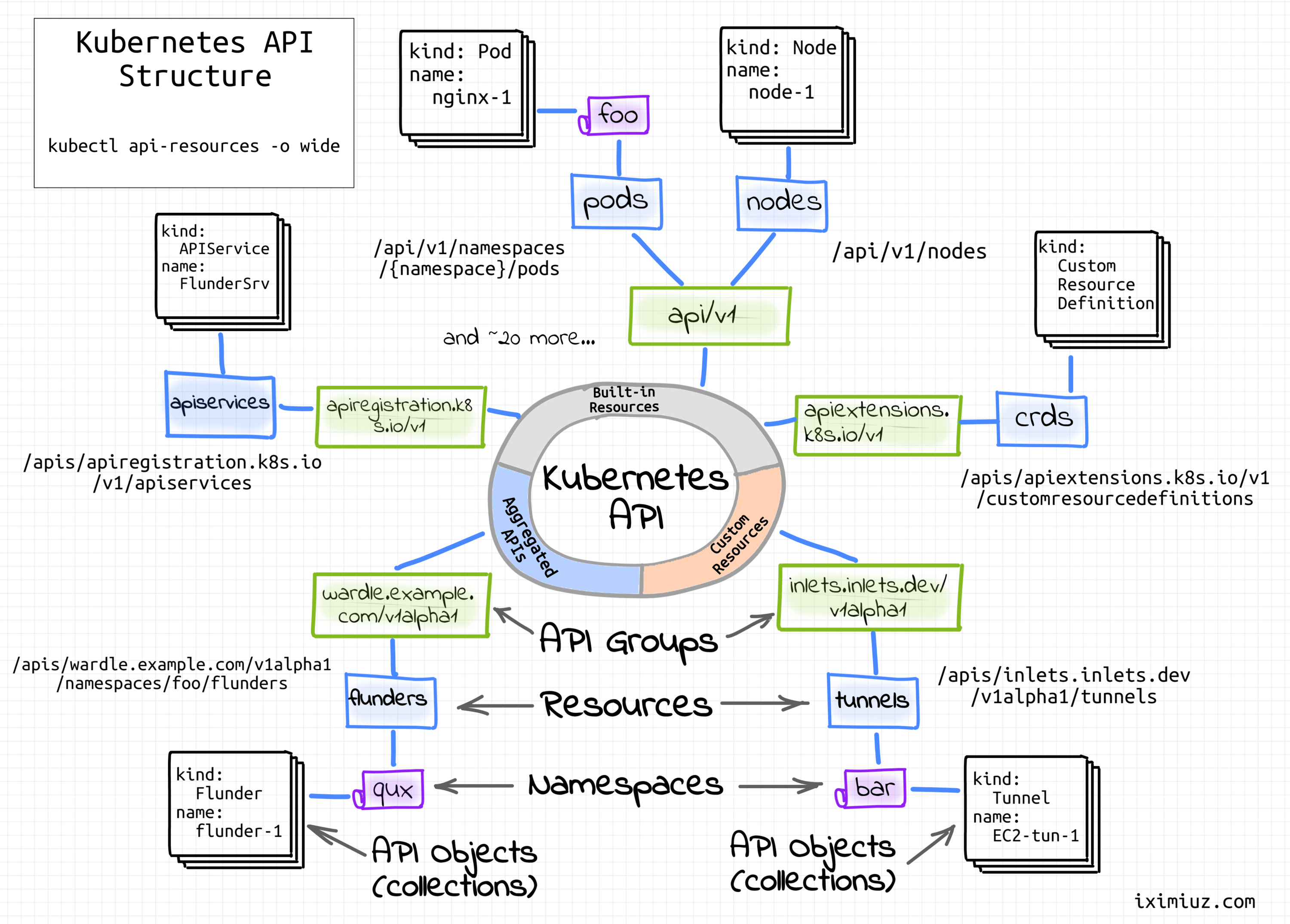references:
- * Kubernetes API
- * Access Clusters Using the Kubernetes API
- The Kubernetes API
- The OAuth 2.0 Authorization Framework: Bearer Token Usage
- * How to Access Kubernetes API Server
- * Access Kubernetes API with Client Certificates
- * Interacting directly with the API
- * Kubernetes API Basics - Resources, Kinds, and Objects
- Accessing Clusters
- * one-page api reference for kubernetes v1.24
- * API Access Control
- using api
- customizing components with the kubeadm api
- workload resources
- Pod
- PodTemplate
- ReplicationController
- ReplicaSet
- Deployment
- StatefulSet
- ControllerRevision
- DaemonSet
- Job
- CronJob
- HorizontalPodAutoscaler
- PriorityClass
- service resources
- Service
- Endpoints
- EndpointSlice
- Ingress
- IngressClass
- config and storage resources
- authentication resources
- authorization resources
- policy resources
- cluster resources
- Node
- Namespace
- Event
- APIService
- Lease
- RuntimeClass
- FlowSchema v1beta2
- PriorityLevelConfiguration v1beta2
- Binding
- ComponentStatus
- common definitions
[!NOTE] There are several different proxies you may encounter when using Kubernetes:
- The kubectl proxy:
- runs on a user's desktop or in a pod
- proxies from a localhost address to the Kubernetes apiserver
- client to proxy uses HTTP
- proxy to apiserver uses HTTPS
- locates apiserver
- adds authentication headers
- The apiserver proxy:
- is a bastion built into the apiserver
- connects a user outside of the cluster to cluster IPs which otherwise might not be reachable
- runs in the apiserver processes
- client to proxy uses HTTPS (or http if apiserver so configured)
- proxy to target may use HTTP or HTTPS as chosen by proxy using available information
- can be used to reach a Node, Pod, or Service
- does load balancing when used to reach a Service
- The kube proxy:
- runs on each node
- proxies UDP and TCP
- does not understand HTTP
- provides load balancing
- is only used to reach services
- A Proxy/Load-balancer in front of apiserver(s):
- existence and implementation varies from cluster to cluster (e.g. nginx)
- sits between all clients and one or more apiservers
- acts as load balancer if there are several apiservers.
- Cloud Load Balancers on external services:
- are provided by some cloud providers (e.g. AWS ELB, Google Cloud Load Balancer)
- are created automatically when the Kubernetes service has type LoadBalancer
- use UDP/TCP only
- implementation varies by cloud provider.

[!NOTE|label:tips:]
- get server
$ server=$(kubectl config view -ojsonpath="{.clusters[*].cluster.server}")get default sa name
$ name=$(kubectl get sa -n default default -ojsonpath="{.secrets[].name}")get token
$ token=$(kubectl get secrets -n default $(kubectl get sa -n default default -ojsonpath="{.secrets[].name}") -o jsonpath="{.data.token}" | base64 -d)- get cacert
$ cacert=$(kubectl config view --raw -ojsonpath="{.clusters[].cluster.certificate-authority-data}" | base64 -d)-H "Authorization: Bearer $token"API path
$ ${server}/api/
acess cluster
$ APISERVER=$(kubectl config view --minify -o jsonpath='{.clusters[0].cluster.server}')
# or get via cluster name of `kubernetes-staging`
$ APISERVER=$(kubectl config view -o jsonpath='{.clusters[?(@.name == "kubernetes-staging")].cluster.server}')
$ TOKEN=$(kubectl get secret default-token -o jsonpath='{.data.token}' | base64 --decode)
$ curl ${APISERVER}/api --header "Authorization: Bearer ${TOKEN}" --insecure
or
$ APISERVER=$(kubectl config view --minify | grep server | cut -f 2- -d ":" | tr -d " ") # or via jsonpath $ APISERVER=$(kubectl config view --minify -o jsonpath='{.clusters[0].cluster.server}') # or get via cluster name of `kubernetes-staging` $ APISERVER=$(kubectl config view -o jsonpath='{.clusters[?(@.name == "kubernetes-staging")].cluster.server}') $ TOKEN=$(kubectl describe secret default-token | grep -E '^token' | cut -f2 -d':' | tr -d " ") $ curl ${APISERVER}/api --header "Authorization: Bearer ${TOKEN}" --insecure { "kind": "APIVersions", "versions": [ "v1" ], "serverAddressByClientCIDRs": [ { "clientCIDR": "0.0.0.0/0", "serverAddress": "<master.ip>:6443" } ] }
access cluster with cacert
$ curl --include \
--cacert <(kubectl config view --raw -ojsonpath="{.clusters[].cluster.certificate-authority-data}" | base64 -d) \
${server}/api/ -H "Authorization: Bearer $token"